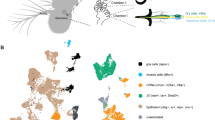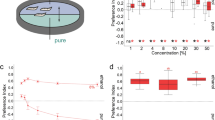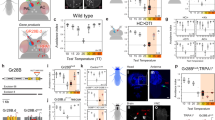Abstract
The ability of insects to learn and navigate to specific locations in the environment has fascinated naturalists for decades. The impressive navigational abilities of ants, bees, wasps and other insects demonstrate that insects are capable of visual place learning1,2,3,4, but little is known about the underlying neural circuits that mediate these behaviours. Drosophila melanogaster (common fruit fly) is a powerful model organism for dissecting the neural circuitry underlying complex behaviours, from sensory perception to learning and memory. Drosophila can identify and remember visual features such as size, colour and contour orientation5,6. However, the extent to which they use vision to recall specific locations remains unclear. Here we describe a visual place learning platform and demonstrate that Drosophila are capable of forming and retaining visual place memories to guide selective navigation. By targeted genetic silencing of small subsets of cells in the Drosophila brain, we show that neurons in the ellipsoid body, but not in the mushroom bodies, are necessary for visual place learning. Together, these studies reveal distinct neuroanatomical substrates for spatial versus non-spatial learning, and establish Drosophila as a powerful model for the study of spatial memories.
This is a preview of subscription content, access via your institution
Access options
Subscribe to this journal
Receive 51 print issues and online access
$199.00 per year
only $3.90 per issue
Buy this article
- Purchase on Springer Link
- Instant access to full article PDF
Prices may be subject to local taxes which are calculated during checkout




Similar content being viewed by others
References
Mizunami, M., Weibrecht, J. M. & Strausfeld, N. J. Mushroom bodies of the cockroach: their participation in place memory. J. Comp. Neurol. 402, 520–537 (1998)
Wessnitzer, J., Mangan, M. & Webb, B. Place memory in crickets. Proc. R. Soc. B 275, 915–921 (2008)
Wehner, R. & Raber, F. Visual spatial memory in desert ants, Cataglyphis bicolor (Hymenoptera: Formicidae). Experientia 35, 1569–1571 (1979)
Cartwright, B. A. & Collett, T. S. How honey bees use landmarks to guide their return to a food source. Nature 295, 560–564 (1982)
Ernst, R. & Heisenberg, M. The memory template in Drosophila pattern vision at the flight simulator. Vision Res. 39, 3920–3933 (1999)
Tang, S. & Guo, A. Choice behavior of Drosophila facing contradictory visual cues. Science 294, 1543–1547 (2001)
Capaldi, E. A. & Dyer, F. C. The role of orientation flights on homing performance in honeybees. J. Exp. Biol. 202, 1655–1666 (1999)
Moser, E. I., Kropff, E. & Moser, M. B. Place cells, grid cells, and the brain’s spatial representation system. Annu. Rev. Neurosci. 31, 69–89 (2008)
Morris, R. G. M. Spatial localization does not require the presence of local cues. Learn. Motiv. 12, 239–260 (1981)
Baines, R. A., Uhler, J. P., Thompson, A., Sweeney, S. T. & Bate, M. Altered electrical properties in Drosophila neurons developing without synaptic transmission. J. Neurosci. 21, 1523–1531 (2001)
McGuire, S. E., Mao, Z. & Davis, R. L. Spatiotemporal gene expression targeting with the TARGET and gene-switch systems in Drosophila . Sci. STKE 2004, pl6 (2004)
Waddell, S. & Quinn, W. G. What can we teach Drosophila? What can they teach us? Trends Genet. 17, 719–726 (2001)
de Belle, J. S. & Heisenberg, M. Associative odor learning in Drosophila abolished by chemical ablation of mushroom bodies. Science 263, 692–695 (1994)
Wolf, R. et al. Drosophila mushroom bodies are dispensable for visual, tactile, and motor learning. Learn. Mem. 5, 166–178 (1998)
Putz, G. & Heisenberg, M. Memories in Drosophila heat-box learning. Learn. Mem. 9, 349–359 (2002)
Heisenberg, M. Mushroom body memoir: from maps to models. Nature Rev. Neurosci. 4, 266–275 (2003)
Neuser, K., Triphan, T., Mronz, M., Poeck, B. & Strauss, R. Analysis of a spatial orientation memory in Drosophila . Nature 453, 1244–1247 (2008)
Strauss, R. The central complex and the genetic dissection of locomotor behaviour. Curr. Opin. Neurobiol. 12, 633–638 (2002)
Bernstein, S. & Bernstein, R. A. Relationships between foraging efficiency and size of head and component brain and sensory structures in red wood ant. Brain Res. 16, 85–104 (1969)
Fahrbach, S. E. & Robinson, G. E. Behavioral development in the honey bee: toward the study of learning under natural conditions. Learn. Mem. 2, 199–224 (1995)
Stocker, R. F. The organization of the chemosensory system in Drosophila melanogaster: a review. Cell Tissue Res. 275, 3–26 (1994)
Tully, T. & Quinn, W. G. Classical conditioning and retention in normal and mutant Drosophila melanogaster . J. Comp. Physiol. A 157, 263–277 (1985)
Wustmann, G., Rein, K., Wolf, R. & Heisenberg, M. A new paradigm for operant conditioning of Drosophila melanogaster . J. Comp. Physiol. A 179, 429–436 (1996)
Zars, T. Spatial orientation in Drosophila . J. Neurogenet. 23, 104–110 (2009)
Morris, R. G., Schenk, F., Tweedie, F. & Jarrard, L. E. Ibotenate lesions of hippocampus and/or subiculum: dissociating components of allocentric spatial learning. Eur. J. Neurosci. 2, 1016–1028 (1990)
Seelig, J. D. et al. Two-photon calcium imaging from head-fixed Drosophila during optomotor walking behavior. Nature Methods 7, 535–540 (2010)
Dombeck, D. A., Harvey, C. D., Tian, L., Looger, L. L. & Tank, D. W. Functional imaging of hippocampal place cells at cellular resolution during virtual navigation. Nature Neurosci. 13, 1433–1440 (2010)
Foucaud, J., Burns, J. G. & Mery, F. Use of spatial information and search strategies in a water maze analog in Drosophila melanogaster. PLoS ONE 5, e15231 (2010)
Reiser, M. B. & Dickinson, M. H. A modular display system for insect behavioral neuroscience. J. Neurosci. Methods 167, 127–139 (2008)
Branson, K., Robie, A. A., Bender, J., Perona, P. & Dickinson, M. H. High-throughput ethomics in large groups of Drosophila. Nature Methods 6, 451–457 (2009)
Sayeed, O. & Benzer, S. Behavioral genetics of thermosensation and hygrosensation in Drosophila. Proc. Natl Acad. Sci. USA 93, 6079–6084 (1996)
Zars, T. Two thermosensors in Drosophila have different behavioral functions. J. Comp. Physiol. A 187, 235–242 (2001)
Strauss, R., Schuster, S. & Gotz, K. G. Processing of artificial visual feedback in the walking fruit fly Drosophila melanogaster. J. Exp. Biol. 200, 1281–1296 (1997)
Wustmann, G. & Heisenberg, M. Behavioral manipulation of retrieval in a spatial memory task for Drosophila melanogaster. Learn. Mem. 4, 328–336 (1997)
Zars, T., Wolf, R., Davis, R. & Heisenberg, M. Tissue-specific expression of a type I adenylyl cyclase rescues the rutabaga mutant memory defect: in search of the engram. Learn. Mem. 7, 18–31 (2000)
Diegelmann, S., Zars, M. & Zars, T. Genetic dissociation of acquisition and memory strength in the heat-box spatial learning paradigm in Drosophila. Learn. Mem. 13, 72–83 (2006)
Dickinson, M. H. Haltere-mediated equilibrium reflexes of the fruit fly, Drosophila melanogaster. Phil. Trans R. Soc. B 354, 903–916 (1999)
de Belle, J. S. & Heisenberg, M. Expression of Drosophila mushroom body mutations in alternative genetic backgrounds: a case study of the mushroom body miniature gene (mbm). Proc. Natl Acad. Sci. USA 93, 9875–9880 (1996)
Pfeiffer, B. D. et al. Tools for neuroanatomy and neurogenetics in Drosophila. Proc. Natl Acad. Sci. USA 105, 9715–9720 (2008)
Martin, J. R., Raabe, T. & Heisenberg, M. Central complex substructures are required for the maintenance of locomotor activity in Drosophila melanogaster. J. Comp. Physiol. A 185, 277–288 (1999)
Acknowledgements
We particularly thank M. Gallio for help with thermosensation and the development of temperature behavioural tests. We also thank G. Rubin for providing GAL4 lines before publication, A. Jenett for their anatomical annotation and M. Dickinson for discussions and advice. Brain images were provided by the Janelia Fly Light Project. T. Laverty and the Janelia Fly Core assisted with Drosophila maintenance. Additional support was provided by J. Osborne, C. Werner, D. Olbris and M. Bolstad. We also thank V. Jayaraman, members of the Reiser and Zuker labs, Janelia Farm colleagues and the Janelia Fly Olympiad Project. This project was supported through the HHMI Janelia Farm Research Campus visitor programmed (T.A.O. and C.S.Z., hosted by M.B.R.). C.S.Z. is a HHMI investigator and a Senior Fellow at Janelia Farm.
Author information
Authors and Affiliations
Contributions
All authors designed the study and wrote the manuscript. T.A.O. carried out the experiments and data analysis.
Corresponding authors
Ethics declarations
Competing interests
The authors declare no competing financial interests.
Supplementary information
Supplementary Information
The file contains Supplementary Figures 1-8 with legends and Supplementary Movie legends. (PDF 5727 kb)
Supplementary Movie 1
The movie shows a typical trial of place learning in the thermal visual arena (see Supplementary Information file for full legend). (MOV 10627 kb)
Supplementary Movie 2
The movie shows a typical probe trial following training with a coupled visual panorama (see Supplementary Information file for full legend). (MOV 3707 kb)
Supplementary Movie 3
This movie shows a typical probe trail following training with an uncoupled visual panorama (see Supplementary Information file for full legend). (MOV 3414 kb)
Rights and permissions
About this article
Cite this article
Ofstad, T., Zuker, C. & Reiser, M. Visual place learning in Drosophila melanogaster. Nature 474, 204–207 (2011). https://doi.org/10.1038/nature10131
Received:
Accepted:
Published:
Issue Date:
DOI: https://doi.org/10.1038/nature10131
This article is cited by
-
Rapid expansion and visual specialisation of learning and memory centres in the brains of Heliconiini butterflies
Nature Communications (2023)
-
Geometry-based navigation in the dark: layout symmetry facilitates spatial learning in the house cricket, Acheta domesticus, in the absence of visual cues
Animal Cognition (2023)
-
Impact of central complex lesions on innate and learnt visual navigation in ants
Journal of Comparative Physiology A (2023)
-
Optic flow based spatial vision in insects
Journal of Comparative Physiology A (2023)
-
Visual navigation: properties, acquisition and use of views
Journal of Comparative Physiology A (2023)
Comments
By submitting a comment you agree to abide by our Terms and Community Guidelines. If you find something abusive or that does not comply with our terms or guidelines please flag it as inappropriate.



